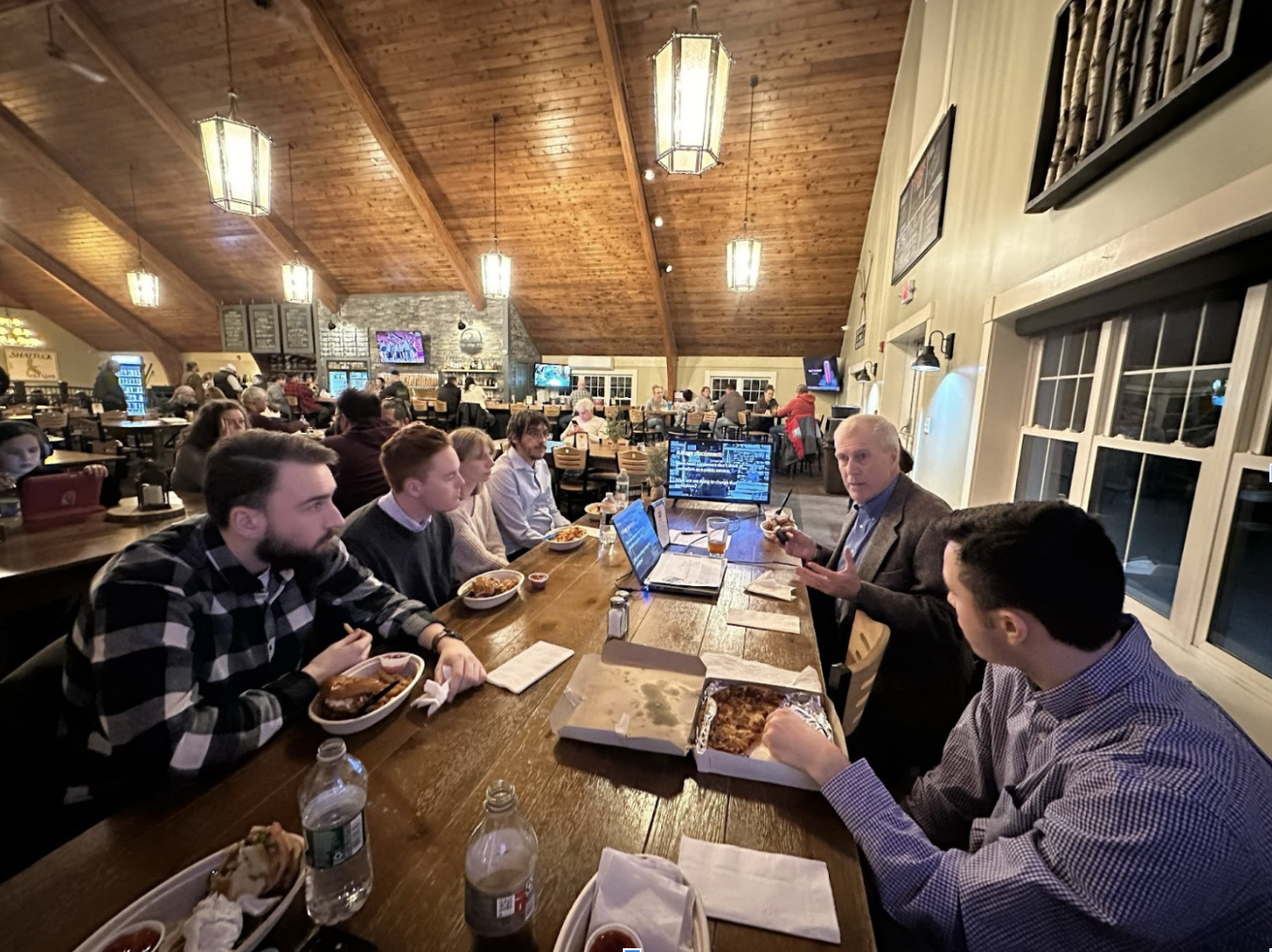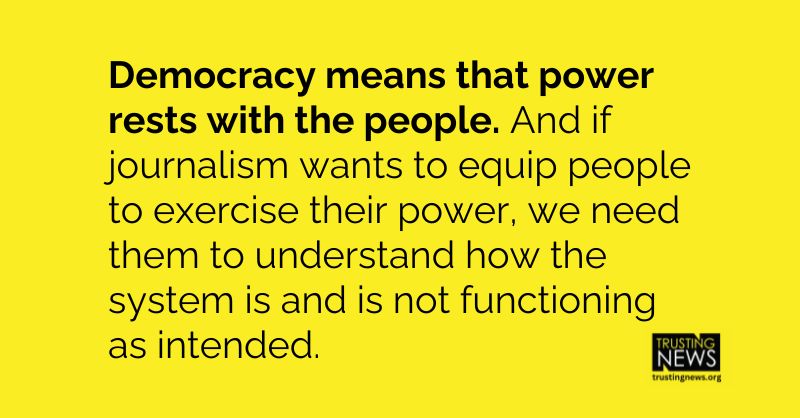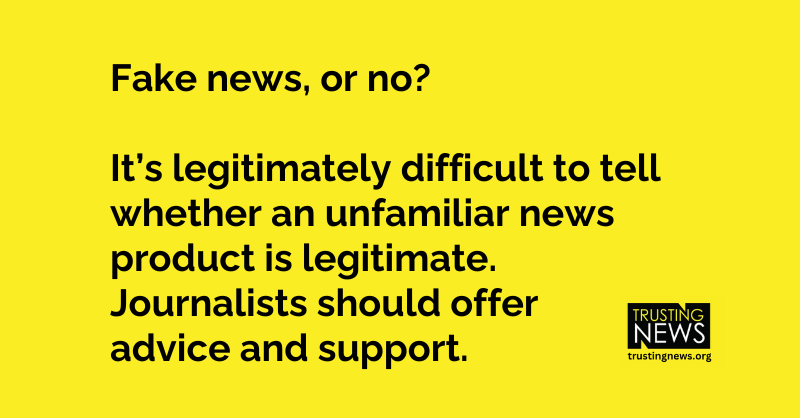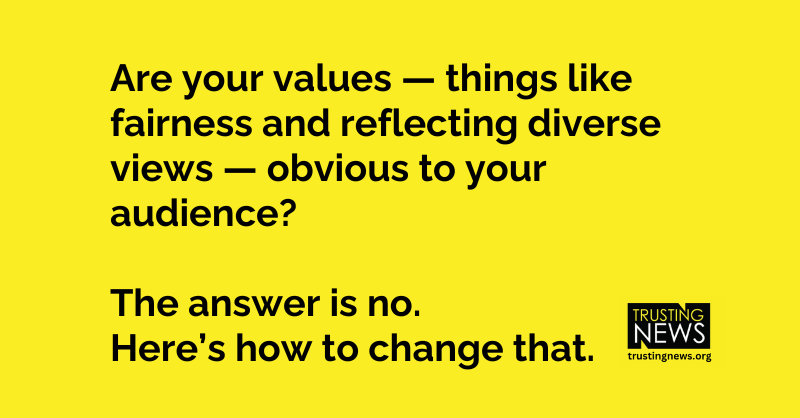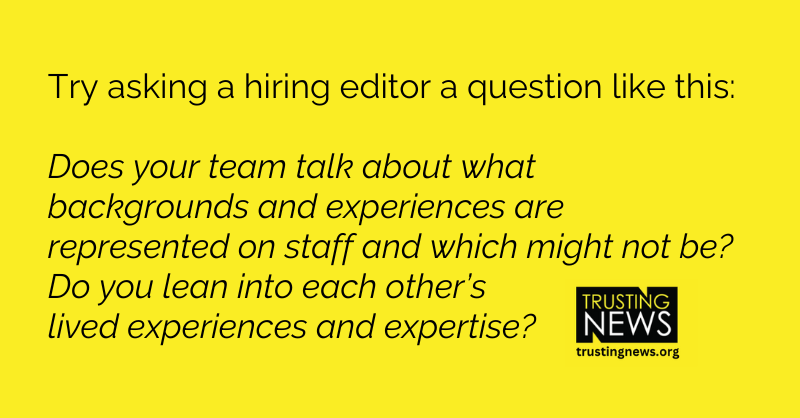
Will a newsroom invite you to share your perspective and values, or will that be discouraged? Here’s how to find out.
When interviewing for jobs, ask these questions about newsroom culture
How does who we are as human beings show up in our journalism — and in our newsroom conversations?
There’s no doubt that what journalists are curious about, what we notice and what we find problematic are influenced by our own lens on the world. There’s also no doubt that a perceived mismatch between a news outlet’s stated values and audience perceptions of those values are a key cause of distrust.
Basically, if you produce news through a set of values, people sure want you to be upfront about those values. And the makeup of your staff is the key ingredient in organizational values.
In some newsrooms, an emphasis is placed on separating our backgrounds, values and identities from our work. And in others, there’s a more open discussion about what we each bring to the collective set of experiences that shape our coverage.
I’m not here to prescribe a specific approach for your newsroom. I will say that through our Dimensions of Difference work, I have seen newsroom after newsroom zero in on things they’re missing because their staff members either lack specific life experiences or do not feel comfortable talking about them.
This issue is fundamentally about the journalism — about a newsroom’s ability to provide coverage that reflects the complexity of their communities and the range of perspectives on the issues. We all can only see what we can see. We all benefit from a colleague saying, “have you thought about it this way?” And I appreciate it so much when journalists are willing to be clear eyed about their own limitations.
I’ll share a fantastic example of that in just a minute. But first …
Let’s talk about the job interview
An interview is a crucial part of the discovery process, when journalists and newsrooms are figuring out if they’re a good fit for each other. It’s one thing to assess someone’s skills, but it’s another to figure out what they would contribute to newsroom values and conversations.
An early offering in our work on this topic was a guide on Hiring for Dimensions of Difference, co-created with partner journalists and HR directors. The guide walks hiring editors through questions they can ask job candidates to get a sense of what perspectives they might bring to the newsroom’s collective lens.
But when talking recently to young journalists soon to be on the job market, I realized THEY needed questions to ask, too. They wanted to know how they could tell if they would be expected to minimize their perspectives and identities in a newsroom or if they would be encouraged to be upfront about them. They’ve witnessed how wrong it can go when the standards for objectivity are not wrestled with but are unilaterally set by editors who view the world in a specific way and prefer not to be challenged.
Questions to ask before accepting a job
A job interview goes both ways, and job candidates should be ready with their own questions. So when an interviewer says “what questions do you have for me,” here are some questions that can help job seekers get an idea for newsroom culture.
- What voices or perspectives do you feel are not represented well enough in your coverage?
- Newsrooms tend to be made up of people who come from similar backgrounds and have similar experiences. Does your team talk about what experiences are represented on staff and which might not be? How do you think about that? Do you lean into each other’s lived experiences and expertise?
- How does your newsroom work to add complexity to coverage and not contribute to polarizing narratives? Can you give me an example?
- Trust in journalists is an issue for all of us, and sometimes distrust is based on people not feeling represented. What kinds of things can you do/have you done to build trust with sources or community members who are otherwise suspicious of you, your outlet or journalists in general?

An example of the power of intellectual diversity
Here’s a question: How many of the reporters covering abortion across the country see the issue through a lens of deep empathy for and understanding of anti-abortion views? I’m sure some come from family or community backgrounds that were rooted in that perspective, and others have developed a nuanced understanding through years of reporting. But I know plenty of anti-abortion news consumers do not feel accurately represented by news coverage.
I love how Isaac Saul, founder of Tangle News, wrote about his staff’s lens on abortion coverage. The premise behind Tangle is producing news that feels accurate and fair across the political spectrum. (Hear him describe it in his TED Talk.) In a piece titled “How to actually win back trust in news,” Saul wrote this about abortion:
If you create a newsroom without tension over language choices, story selection, and what quotes to feature prominently in an article, you won’t have a balanced newsroom.
A couple of years ago, when I was first building my team, we hired an intern from Tennessee who had unabashed pro-life views. Since I’m someone with a generally pro-choice perspective, she was the single most important person on my staff any time we covered abortion. I sought out her opinions to challenge our coverage. I asked her for blind spots. I insisted she suggest edits that we could discuss. She didn’t just make our coverage more balanced, she made it better — smarter, more expansive, and more holistic. She helped us touch on a controversial issue in a way that was accessible for all people, regardless of how they felt about the core issue at hand.
That is the power of diversity of thought in a newsroom. And it’s sorely lacking from both right-leaning and left-leaning news outlets today.
I have one quibble with this: The adjective “unabashed” implies that perhaps it would have been logical for the intern to have been embarrassed by her views, or shy about them. While that could be true — I certainly hear from journalists who don’t feel able to be open about their conservative views in their newsrooms — the inclusion of the word is a sad commentary on the state of newsrooms.
Our guide is always a work in progress!
If you use our suggested questions either as a hiring editor or as a job candidate, let us know how it goes. (We’d never quote you without permission.) And if you have ideas for additions or edits, send them to info@TrustingNews.org.
At Trusting News, we learn how people decide what news to trust and turn that knowledge into actionable strategies for journalists. We train and empower journalists to take responsibility for demonstrating credibility and actively earning trust through transparency and engagement. Learn more about our work, vision and team. Subscribe to our Trust Tips newsletter. Follow us on Twitter, BlueSky and LinkedIn.
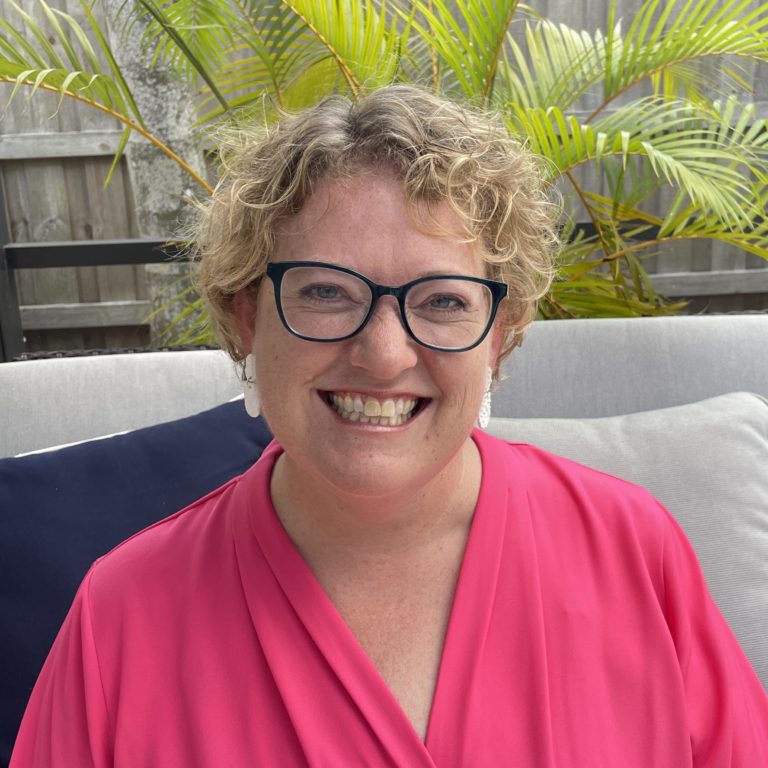
Executive Director Joy Mayer (she/her) founded Trusting News in 2016 after a 20-year career in newsrooms and teaching. She lives in Sarasota, Florida, and can be reached at joy@TrustingNews.org.
